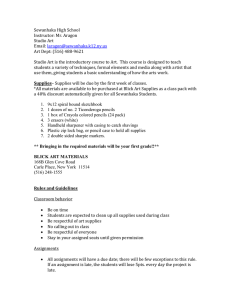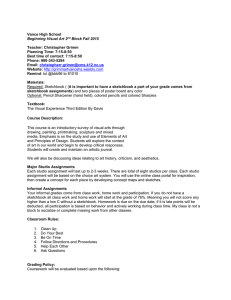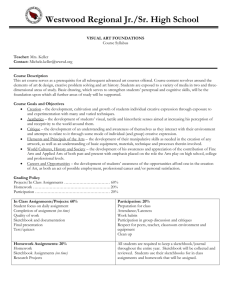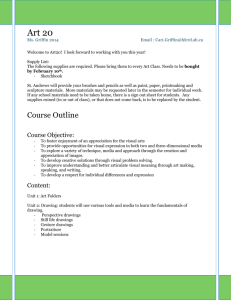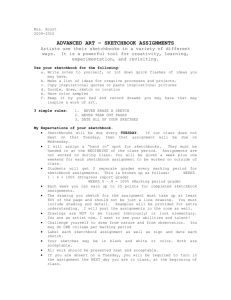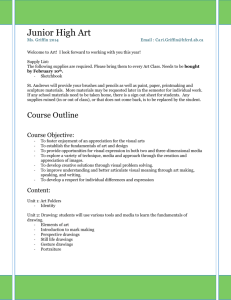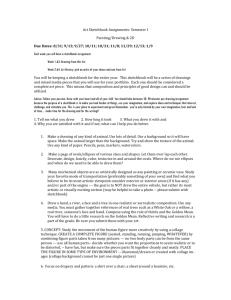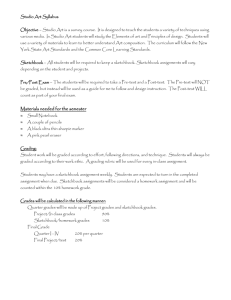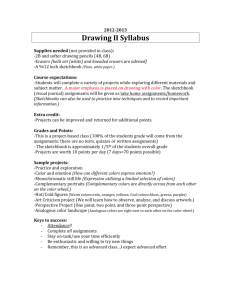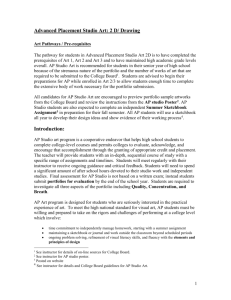Summer Drawing Assignments
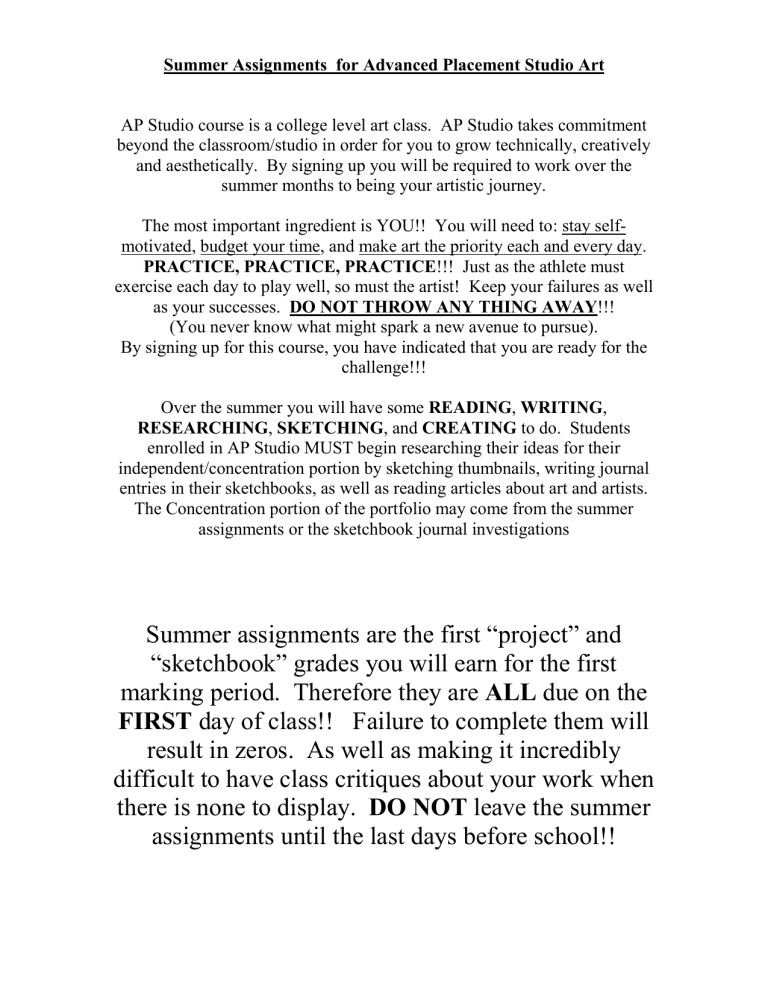
Summer Assignments for Advanced Placement Studio Art
AP Studio course is a college level art class. AP Studio takes commitment beyond the classroom/studio in order for you to grow technically, creatively and aesthetically. By signing up you will be required to work over the summer months to being your artistic journey.
The most important ingredient is YOU!! You will need to: stay selfmotivated, budget your time, and make art the priority each and every day.
PRACTICE, PRACTICE, PRACTICE !!! Just as the athlete must exercise each day to play well, so must the artist! Keep your failures as well as your successes. DO NOT THROW ANY THING AWAY !!!
(You never know what might spark a new avenue to pursue).
By signing up for this course, you have indicated that you are ready for the challenge!!!
Over the summer you will have some READING , WRITING ,
RESEARCHING , SKETCHING , and CREATING to do. Students enrolled in AP Studio MUST begin researching their ideas for their independent/concentration portion by sketching thumbnails, writing journal entries in their sketchbooks, as well as reading articles about art and artists.
The Concentration portion of the portfolio may come from the summer assignments or the sketchbook journal investigations
Summer assignments are the first “project” and
“sketchbook” grades you will earn for the first marking period. Therefore they are ALL due on the
FIRST day of class!! Failure to complete them will result in zeros. As well as making it incredibly difficult to have class critiques about your work when there is none to display. DO NOT leave the summer assignments until the last days before school!!
READING ASSIGNMENTS:
ALL students MUST read the entire AP Studio Poster
Highlight important information or any areas in question. Bring this to class on the first day of the school year.
RESEARCH ASSIGNMENT:
Select from the list ONE artist that you would like to investigate further. BEGIN the research, find some one that connects with you. Collect every thing about this artist, images that you are drawn to, read articles that the artist wrote or was the subject of. Print out anything and everything about this person that may give you insight to their art. Go beyond the traditional biography of the person, read and research why they do what they do. Get into their heads, be a “fly on the wall” of their studio while they work, absorb the concepts of why they create, and how were they viewed by the public and critics? *
if, on your research journey it takes you off this list of artists you may continue to research that new artist, but you MUST be able to explain and defend your selection when we meet.
Max Beckman
Robert Delaunay
Jim Dine
Arshile Gorky
Romare Bearden
Alice Neel
Jasper Johns
George Grosz
Jorg Immendorff
Jacob Lawerence
Thomas Hart Benton
Robert Raushenberg
Richard Diebenkorn
Frida Kahlo
Ernest L. Kirchner
Paul Klee Willem DeKooning Sigmar Polke
Amedeo Modigliani Andrew Wyeth Ansel Adams
Katha Kollowiz
Lewis Hine
Sonia Delaunay
Imogen Cunningham
Audrey Flack
Carl Blossfeld
Walker Evans
Georgia O’Keeffe
Judy Chicago
Lewis Hine
Hans Hofmann
Bridget Riley
Barbara Kruger
Dorthea Lange
Robert Arneson
Julian Schnabel Sean Scully
Helen Frankenthaler Ben Shann
Faith Ringgold
Maya Lin
Make a folder of all the articles and the reading materials that you have collected and printed out about your favorite artist. Include in the folder images of your favorite pieces by the artist. Please read and highlight important information, you can even make notes in the margins if it helps.
Bring in this folder on the first day of class. (Magazines and Journals of importance ie: ART NEWS & ART IN AMERICA)
SKETCHBOOK ASSIGNMENT SELECTIONS:
All students are expected to have sketchbooks at all times and to develop these sketchbooks as your ongoing mental process, and personal reflections.
Both directed and non-directed work should become a part of the contents with in the sketchbook journal. Sketchbook journals will be used to document the MANADORY ideation process for
“in class”
and
“out of class” projects. Please remember that all drawings MUST come from
DIRECT OBSERVATION !!
Sketchbook size should be NO smaller than 8” x 10” and NO bigger than
12” x 18”.
Please write the answer to this question in your sketchbook/journal (try your best….we will refine this at a later date)
WHAT IS MY PERSONAL ARTISTIC INTEREST, AND
HOW CAN I EFFECTIVELY COMMUNICATE THIS
THROUGH A VISUAL FORMAT?
Try contour line, gesture line, completed value drawings with strong darks and lights, color, mark making techniques and try a different drawing implement (like a fat marker, chalk, dip a stick in India ink etc..)
I expect to see drawings/studies from EACH of the following suggested categories:
PEOPLE: your family, friends, strangers (try them still, “watching
TV”, or capture movement “the playground”)
STILL-LIFE: arrangements of dishes, lemons etc. Keep your set up for several sittings. Do several views of the same still-life, and finish one with beautifully rendered areas.
LANDSCAPE: observe and record your surroundings, go for a nature walk, a boat ride (Do not forget to wear Sun Screen)!!!
MECHANICS: something man made, a car engine, wheel, bike, the air conditioner, and furnace, find something linear.
DRAWING/PAINTING ASSIGNMENT SELECTIONS:
The following projects are to be completed over the summer in ADDITION to the sketchbook assignments. These should be done on good quality paper or canvas board purchased at the art supply store. Before you begin please draw a 1” border around any assignment rendered on paper. Pay close attention to overall design, use of the page, light source, cast shadows, and reflected light. Draw from REAL LIFE; actually sit in front of what you are drawing!!!
The size of the paper or the canvas MUST be NO smaller than 12” x 18” and
NO larger than 18” x 24”.
You may use any media or a combination of several. (Charcoal, pencil or color (pencils, pastels, paint)).
Hint: Students should work on more than one piece at a time.
Please select and complete (Portfolio worthy)
5
from the following assignments:
Remember that the 4 edges of the picture plane are the four most important lines of your composition. Go to the edges on all of the selected assignments. Do not forget to handle the background; your objects or people should not be floating in an ambiguous space. Your image needs 3 layers or strata
(background, middle ground and foreground). GOOD LUCK!!
1) Recall a dream, memory or emotion and create a scene that captures that mood and it’s meaning for you, & the feelings it brought fourth. Use color to help evoke the mood.
2) Draw your kitchen sink from an interesting point of view
INCLUDE the surrounding spaces and the “stuff” in and around the space.
3) Large figure study: using a warm colored background: use Indigo and white. Indigo is the dark values, white shows the light values and the paper is the middle value. Focus on composition and proportion.
4) Under lit, Expressive Self Portrait: Set up a light source that illuminates your face from below. Focus on your expression and light source. Try to convey a clear mood.
5) Look in or out. Interior Spaces. From a doorway or window.
Both interior and the exterior spaces should be clearly pictured.
Try showing depth in your work. The viewer should be able to
“walk” into the drawing and feel the physical space.
6) A Metallic Reflection that shows Life. Find a metallic object with a large reflective area. Draw the object as a still-life, but pay close attention to the reflection. The reflection should clearly show life around it such as people, color and objects.
7) Hands that Show Emotion. Overlap and entwine hands creating interesting negative and positive spaces. Make the hands show emotion through their composition, use of value and color. Handle the background as well.
8) Birds Eye or Worms Eye View. Focus on Exaggerated Scale and
Perspective. Find an object that has clear visual interest. Perch yourself above or below it, and draw, paying close attention to perspective and form.
9) Five Eggs and a Bath Towel. Set up a still-life. Concentrate on the round forms of the eggs in contrast to the texture of the towel.
Take time to place the eggs and develop a strong composition.
10)
Inside out. Investigate nature’s interiors and exteriors. Cut things open and see its textures and design. Use a view finder to frame your composition. Change the scale, abstract it.
11) Urban Settings. Take it outside. Go for a drive and see the world around you. Do different times of day, different point of view, create an accurate perspective drawing. Deal with the complexity of angles showing both 1 & 2 point perspective.
12) Explore your daily surroundings. Intentionally observe their details, create a composition that best describes who you are by the things or stuff around you then make them the subject of your work of art.
